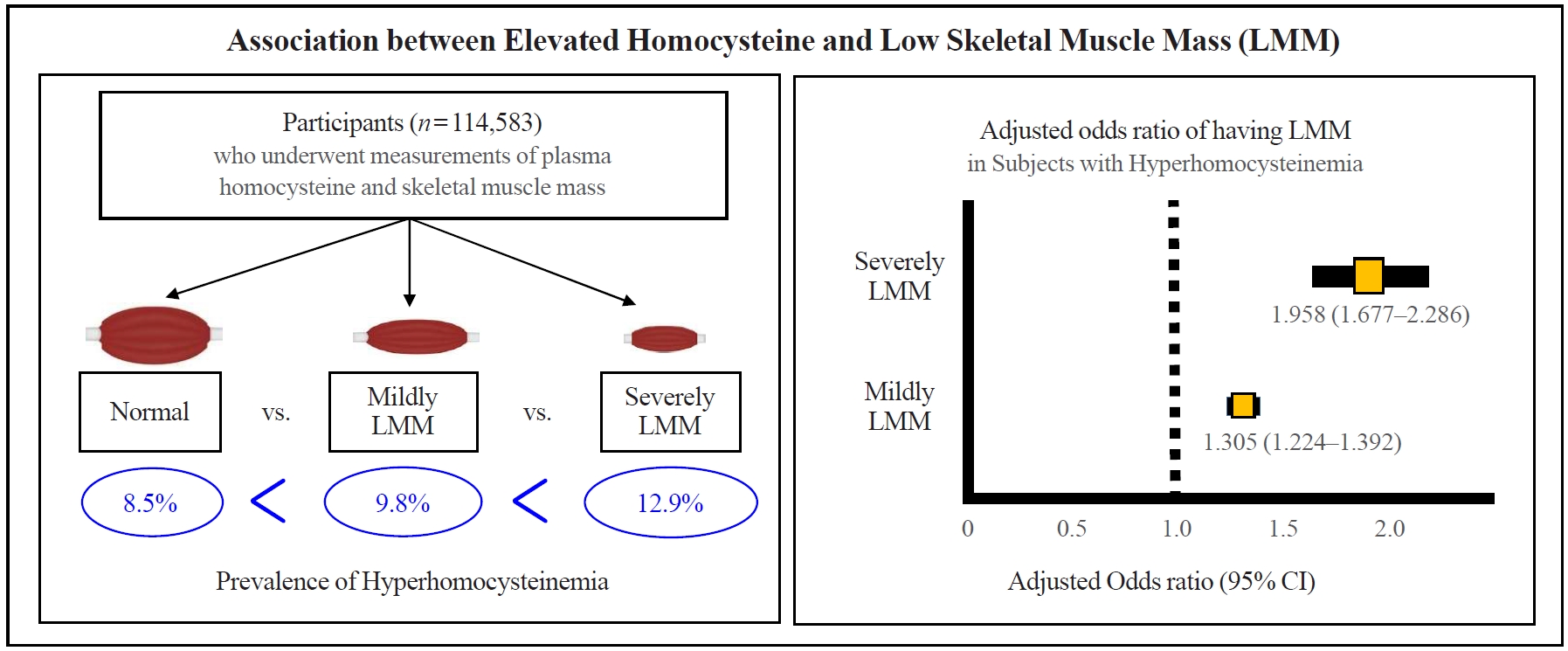- Miscellaneous
- Association between N-Terminal Prohormone Brain Natriuretic Peptide and Decreased Skeletal Muscle Mass in a Healthy Adult Population: A Cross-Sectional Study
-
Tae Kyung Yoo, Marie Yung-Chen Wu, Moon Soo Kim, Mi-Yeon Lee, Yong-Taek Lee, Kyung Jae Yoon, Chul-Hyun Park
-
Endocrinol Metab. 2023;38(2):269-276. Published online March 13, 2023
-
DOI: https://doi.org/10.3803/EnM.2022.1588
-
-
 Abstract Abstract
 PDF PDF PubReader PubReader  ePub ePub
- Background
Although an inverse association between the N-terminal prohormone brain natriuretic peptide (NT-proBNP) and obesity exists, only few major studies have assessed the association between NT-proBNP levels and skeletal muscle mass in asymptomatic healthy adults. Therefore, this cross-sectional study was conducted.
Methods
We assessed participants who underwent health examinations at Kangbuk Samsung Hospital in South Korea from January 2012 to December 2019. Appendicular skeletal muscle mass was measured using a bioelectrical impedance analyzer, and the skeletal muscle mass index (SMI) was calculated. Participants were divided into the control, mildly low skeletal muscle mass (LMM) (−2 standard deviation [SD] < SMI ≤−1 [SD]), and severely LMM groups (SD ≤−2) based on their SMI. The association between elevated NT-proBNP level (≥125 pg/mL) and skeletal muscle mass was assessed using multivariable logistic regression analysis with adjustment for confounding factors.
Results
This study enrolled 15,013 participants (mean age, 37.52±9.52; men, 54.24%; control, n=12,827; mildly LMM, n=1,998; severely LMM, n=188). Prevalence of elevated NT-proBNP was higher in mildly and severely LMM groups than in the control group (control, 1.19%; mildly LMM, 1.4%; severely LMM, 4.26%; P=0.001). The adjusted odds ratio (OR) of elevated NT-proBNP was significantly higher in severely LMM (OR, 2.87; 95% confidence interval [CI], 1.3 to 6.37) than in control (OR, 1.00; reference) or mildly LMM groups (OR, 1.24; 95% CI, 0.81 to 1.89).
Conclusion
Our results showed that NT-proBNP elevation were more prevalent in participants with LMM. In addition, our study showed an association between skeletal muscle mass and NT-proBNP level in a relatively young and healthy adult population.
- Calcium & Bone Metabolism
- Association between Elevated Plasma Homocysteine and Low Skeletal Muscle Mass in Asymptomatic Adults
-
Jae-Hyeong Choi, Jin-Woo Seo, Mi-Yeon Lee, Yong-Taek Lee, Kyung Jae Yoon, Chul-Hyun Park
-
Endocrinol Metab. 2022;37(2):333-343. Published online February 8, 2022
-
DOI: https://doi.org/10.3803/EnM.2021.1202
-
-
7,933
View
-
188
Download
-
6
Web of Science
-
6
Crossref
-
 Abstract Abstract
 PDF PDF Supplementary Material Supplementary Material PubReader PubReader  ePub ePub
- Background
Homocysteine has been drawing attention with a closed linkage with skeletal muscle. However, the association of hyperhomocysteinemia with decreased skeletal muscle mass remains unclear. We aimed to investigate the association of hyperhomocysteinemia with low skeletal muscle mass (LMM) in asymptomatic adults.
Methods
This was a cross-sectional study of 114,583 community-dwelling adults without cancer, stroke, or cardiovascular diseases who underwent measurements of plasma homocysteine and body composition analysis from 2012 to 2018. Hyperhomocysteinemia was defined as >15 μmol/L. Skeletal muscle mass index (SMI) was calculated based on appendicular muscle mass (kg)/height (m)2. Participants were classified into three groups based on SMI: “normal,” “mildly low,” and “severely low.”
Results
The prevalence of hyperhomocysteinemia was the highest in subjects with severely LMM (12.9%), followed by those with mildly LMM (9.8%), and those with normal muscle mass (8.5%) (P for trend <0.001). In a multivariable logistic regression model, hyperhomocysteinemia was significantly associated with having a mildly LMM (odds ratio [OR], 1.305; 95% confidence interval [CI], 1.224 to 1.392) and severely LMM (OR, 1.958; 95% CI, 1.667 to 2.286), respectively. One unit increment of log-transformed homocysteine was associated with 1.360 and 2.169 times higher risk of having mildly LMM and severely LMM, respectively.
Conclusion
We demonstrated that elevated homocysteine has an independent association with LMM in asymptomatic adults, supporting that hyperhomocysteinemia itself can be a risk for decline in skeletal musculature.
-
Citations
Citations to this article as recorded by  - The role of the mitochondrial trans-sulfuration in cerebro-cardio renal dysfunction during trisomy down syndrome
Sathnur Pushpakumar, Mahavir Singh, Utpal Sen, N. Tyagi, Suresh C. Tyagi
Molecular and Cellular Biochemistry.2024; 479(4): 825. CrossRef - Association of vitamins B1 and B2 intake with early-onset sarcopenia in the general adult population of the US: a cross-sectional study of NHANES data from 2011 to 2018
Sha Yang, Zhenyu Dong, Jiaqi Zhao, Lijia Yuan, Yao Xiao, Xing Luo, Zhuyang Zhao, Xia Kang, Kanglai Tang, Ming Chen, Liu Feng
Frontiers in Nutrition.2024;[Epub] CrossRef - Association of Triglyceride-Glucose Index with the Risk of Hyperhomocysteinemia Among Chinese Male Bus Drivers: A Longitudinal Study
Juan Xiong, Yanxia Wu, Lingling Huang, Xujuan Zheng
International Journal of General Medicine.2023; Volume 16: 2857. CrossRef - Relationship between hyperhomocysteinemia and coexisting obesity with low skeletal muscle mass in asymptomatic adult population
Tae Kyung Yoo, Hye Chang Rhim, Yong-Taek Lee, Kyung Jae Yoon, Chul-Hyun Park
Scientific Reports.2022;[Epub] CrossRef - Causal effects of homocysteine levels on the components of sarcopenia: A two-sample mendelian randomization study
Hongwei Yu, Gan Luo, Tianwei Sun, Qiong Tang
Frontiers in Genetics.2022;[Epub] CrossRef - Association between serum homocysteine and sarcopenia among hospitalized older Chinese adults: a cross-sectional study
Bing Lu, Lingyu Shen, Haiqiong Zhu, Ling Xi, Wei Wang, Xiaojun Ouyang
BMC Geriatrics.2022;[Epub] CrossRef
|







